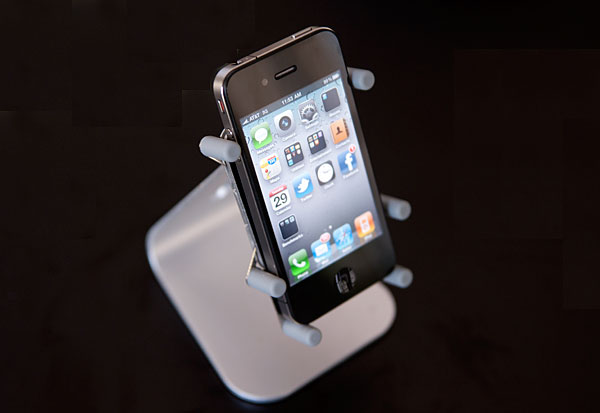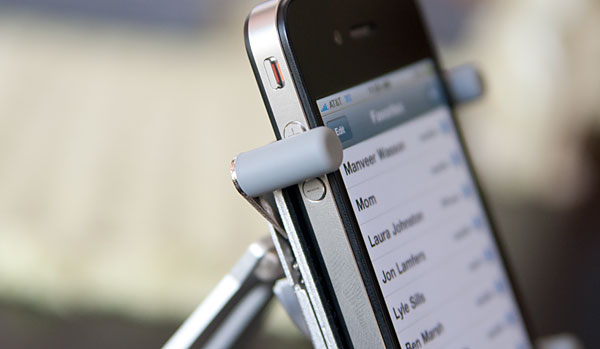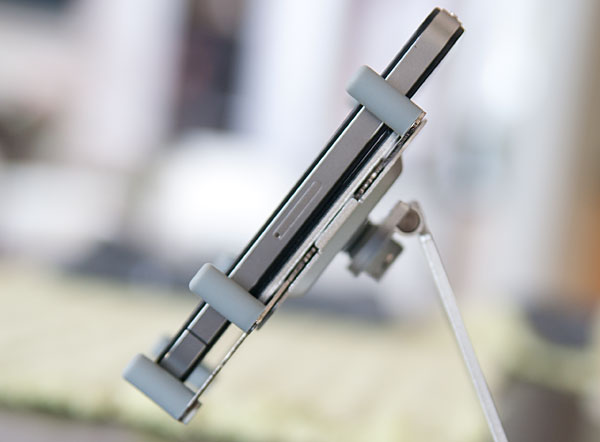Apple's iPhone 4: Thoroughly Reviewed
by Brian Klug & Anand Lal Shimpi on June 30, 2010 4:06 AM EST- Posted in
- Smartphones
- Apple
- iPhone 4
- Gadgets
- Mobile
Sidebar: Luxa2 H1-Touch, a Great FaceTime Stand
Not too long ago I visited Thermaltake while I was in California. Thermaltake recently spun off a brand called Luxa2. This brand would focus on more lifestyle products, leaving Thermaltake to the typical PC stuff like cases and powersupplies.
One of Luxa2’s first products was the H1 Touch, an iPhone/iPod Touch cradle. The idea was to be able to hold your iPhone while you’re in the kitchen so you could read recipes or emails without potentially dumping a bunch of flour or oil on your phone. When the 4 was announced, Thermaltake was quite pleased - the H1 Touch would be perfect for FaceTime.

Indeed it is.
The iPhone 4 sits comfortably against a cushioned black pad that holds the back of the phone very well. There are six rubber feet that hold the outside of the phone, they move as one and allow you to maintain a snug fit. The 4 isn’t falling out of there. The only problem here is that one of the feet obstructs the volume up button, so you’ll have to take the phone out of the H1 to increase volume.


The cradle can tilt and rotate, making it far more flexible than the Apple dock for FaceTime. If you are planning on putting in some hours with FaceTime, I’d say the H1 (or perhaps the new H2?) is a must have. It sells for $29.99, the same price as Apple’s dock. It isn’t technically a dock but the connector is still exposed and the cable still works, it’s just not as neat as Apple’s solution. Way more functional for FT though.










270 Comments
View All Comments
bplewis24 - Monday, July 12, 2010 - link
Consumer Reports confirms what I have commented on earlier about this article: that the "best case scenario" testing of one phone is clearly an attempt to excuse away this clear design flaw in a biased review. See the article here: http://blogs.consumerreports.org/electronics/2010/... .And watch the video. This testing was done in a controlled environment with an RF Isolation Chamber that is impervious to outside radio signals. I suggest you guys stop misleading the tech nerd population with this review now, and revise it.
Brandon
plastic_avatar - Monday, July 12, 2010 - link
How can you not respect the research of someone who slides in an apt geek reference?zholy - Tuesday, July 13, 2010 - link
Only Apple can release a product with such a design flaw and respond to complaints with either "you're holding it wrong" or "buy another product to make it work correctly". Any other company would have their product returned in droves, Mac fanatics just say "ok"Hengie2000 - Saturday, July 17, 2010 - link
Help! I am a wireless tech that uses field test daily to survey in building wireless projects, but the iphone 4 or 4.0 upgrade lost that capability. I am willing to pay for someone to make a field test app or follow the steps that Brian and Anand have listed in this story. Is there any way to reach these guys for more details to get field test running on the iphone4? Does this give full field test menus or only replaces the signal bars with decibels?Stang289 - Monday, July 26, 2010 - link
It would be great if you had Palm Pre Plus and Pixi Plus performance numbers included in smartphone reviews. I would like to see how they stack up against other smartphones.marxster - Thursday, September 9, 2010 - link
...after all that, I'll give you my real world experience. We have a 3Gs and a 4 in our household. The 3Gs always shows more bars and does not drop calls at all while my iPhone 4 does drop calls and has less bars.We live far away from the closest tower and the iphone 4 doesn't ever get better reception here than -103db.
I'm now afraid to receive calls because I know they'll be dropped. Makes my phone useless.
I should say that both phones are on the latest iOS version and there isn't much of a difference whether I use a case or not.
By the way, please explain this to me. Why did Apple bother to spend millions of dollars shipping out cases when they clearly don't get rid of the problem. When I cup my phone with the case on, the bars drop just the same as without.
MisterQED - Wednesday, October 20, 2010 - link
I am not a member of the “tin foil hat” crowd, I’m a guy with a physics degree and a Ham license, so I know a bit about radios. What I am about to point out seems so obvious to me, but I have never heard it discussed anywhere. Your article discusses the effects of having a exposed antenna as it effects phone reception, but that misses the main point, this is a receiving and transmitting antenna. Having skin contact with a transmitting antenna is not safe. Allow me to explain my thought process and tell me if I have a flaw in my logic.1) Constant irritation causes cancer. Whether it is fiberglass fibers, silica dust or coal dust in our lungs, to UV radiation from skin exposed to the sun, if you irritate an area consistently for long periods of time, you are just asking for cancer.
2) RF radiation from most phones is a subject of worry and present discussion, but it doesn’t worry me. RF radiation is a worry because it will cause electrical conduction thru body tissue. This would be an irritation and consistent irritation can lead to cancer. RF radiation from most phones has two methods of conduction, capacitive and inductive.
a) Capacitive needs: a sizable area, small dielectric distances and high frequencies. Cell phones have the high frequencies, but all other designs keep minimal gaps between antennas and the operator’s skin. Also the operator’s finger tips provide a rather small area to support capacitive conductance.
b) Inductive conduction needs frequency matched radiators to allow conduction i.e. a good antenna on each end. Body parts make poor antennas, and bodily dimensions generally don’t match the proportions of ideal radiators, so inductive conduction isn’t really a worry.
3) iPhone 4s, unlike any previous device, allow a third and a magnitude more effective connection between an operator and a transmitting antenna, a resistive connection. All a resistive connection needs is a low resistance, which skin has when sweaty or damp and the antenna has if it is not covered by a non-conductive coating. To add insult to injury, this contact de-tunes the antenna making it less efficient. This inefficiency causes the transmitter to up the power output as cell phones work on a “yell loud enough to be heard” system, so the worse the reception the more power the phone will pump into the antenna to be able to communicate with the cell tower.
So unless you can show me where my logic has lead me astray, I would expect that in the future some percentage of the population that use an iPhone without a case may find a small possibly cancerous mole forming on one of their fingertips.
That is a bigger problem than some dropped calls, so why didn’t you mention it.
smithpercy - Sunday, November 14, 2010 - link
Does this mean that I could cold weld a suitable socket to the gsm antenna side strip to allow a patch cable to an external antenna and get reception in the very marginal areas that I spend most of my time in?? I know that the shield would have to be grounded but that could be done thru one of the other connectors. I understand that would void the warranty, and give apple a conniption fit but that is their problem.keri - Thursday, February 24, 2011 - link
serious question here.jessicacoles - Saturday, December 12, 2020 - link
https://reviewsicon.com/